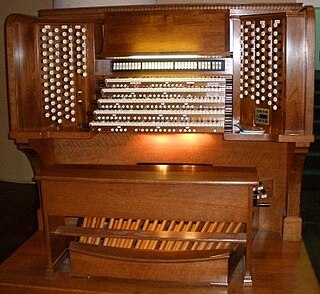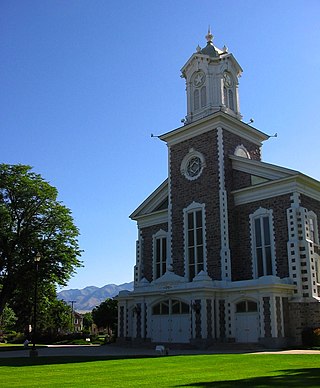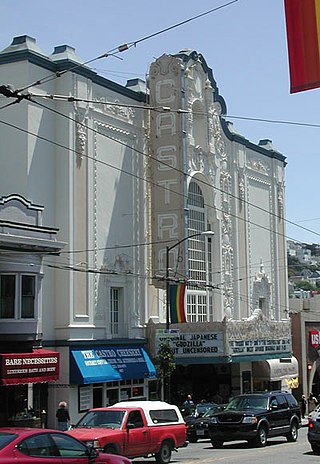
The pipe organ is a musical instrument that produces sound by driving pressurised air through the organ pipes selected from a keyboard. Because each pipe produces a single pitch, the pipes are provided in sets called ranks, each of which has a common timbre, volume, and construction throughout the keyboard compass. Most organs have many ranks of pipes of differing pitch, timbre, and volume that the player can employ singly or in combination through the use of controls called stops.

In music, the organ is a keyboard instrument of one or more pipe divisions or other means for producing tones. The organs have usually two or three, up to five, manuals for playing with the hands and a pedalboard for playing with the feet. With the use of registers, several groups of pipes can be connected to one manual.

The Cathedral Basilica of Saint Louis, also known as the Saint Louis Cathedral, is a Catholic cathedral in the Central West End neighborhood of St. Louis, Missouri. Completed in 1914, it is the mother church of the Archdiocese of St. Louis and the seat of Archbishop Mitchell T. Rozanski. The cathedral is named for Saint Louis and was designated a basilica by Pope John Paul II in 1997.

An organ stop is a component of a pipe organ that admits pressurized air to a set of organ pipes. Its name comes from the fact that stops can be used selectively by the organist; each can be "on", or "off".

Rodgers Instruments Corporation is an American manufacturer of classical and church organs. Rodgers was incorporated May 1, 1958 in Beaverton, Oregon by founders, Rodgers W. Jenkins and Fred Tinker, employees of Tektronix, Inc., of Portland, Oregon, and members of a Tektronix team developing transistor-based oscillator circuits. Rodgers was the second manufacturer of solid state oscillator-based organs, completing their first instrument in 1958. Other Rodgers innovations in the electronic organ industry include solid-state organ amplifiers (1962), single-contact diode keying (1961), reed switch pedal keying for pedalboards (1961), programmable computer memory pistons (1966), and the first MIDI-supported church organs (1986).

An electric organ, also known as electronic organ, is an electronic keyboard instrument which was derived from the harmonium, pipe organ and theatre organ. Originally designed to imitate their sound, or orchestral sounds, it has since developed into several types of instruments:
Mathias Peter Møller, commonly known as M.P. Möller or Moeller, was a prolific pipe-organ builder and businessman. A native of the Danish island of Bornholm, he emigrated to the United States in 1872 and founded the M.P. Moller Pipe Organ Company in Greencastle, Pennsylvania, in 1875. The city of Hagerstown, Maryland, took notice of Möller's early successes and induced him to move his business there in 1881 to help make it a viable business center in Western Maryland. The company remained in business in Hagerstown until 1992, with hundreds of employees at its peak and a lifetime production of over 12,000 instruments.

The symphonic organ is a style of pipe organ that flourished during the first three decades of the 20th century in town halls and other secular public venues, particularly in the United States and the United Kingdom. It has roots in 19th-century Europe, and is a variation of the classical pipe organ. It features expanded capabilities, with many pipes imitative of orchestral instruments, and with multiple expressive divisions and organ console controls for seamlessly adjusting volume and tone, generally with electric organ actions and winding. These expansions let the organist approximate a conductor's power to shape the tonal textures of Romantic music and orchestral transcriptions. These organs are generally concert instruments as opposed to church organs. The symphonic organ has seen a revival in the US, Europe and Japan, particularly since the 1980s.

The Wanamaker Grand Court Organ, located in Philadelphia, Pennsylvania, is the largest fully functioning pipe organ in the world, based on the number of playing pipes, the number of ranks and its weight. The Wanamaker Organ is located within a spacious 7-story Grand Court at Macy's Center City and is played twice a day Monday through Saturday. The organ is featured at several special concerts held throughout the year, including events featuring the Friends of the Wanamaker Organ Festival Chorus and Brass Ensemble.

The Cathedral of Mary Our Queen is a Roman Catholic cathedral located Baltimore, Maryland, United States. It was completed in 1959.

Heinz Memorial Chapel is a Pittsburgh History and Landmarks Foundation Historic Landmark and a contributing property to the Schenley Farms National Historic District on the campus of the University of Pittsburgh in Pittsburgh, Pennsylvania, United States.

Austin Organs, Inc., is a manufacturer of pipe organs based in Hartford, Connecticut. The company is one of the oldest continuously-operating organ manufacturers in the United States. The first instruments were built in 1893 with the Austin Patent Airchest, and many remain in fine playing condition to this day.

St. Stephen's Cathedral is a baroque church from 1688 in Passau, Germany, dedicated to Saint Stephen. It is the seat of the Catholic Bishop of Passau and the main church of his diocese.

The United States Naval Academy Chapel in Annapolis, Maryland, is one of nine designated chapel spaces on the grounds of the United States Navy's service academy. Protestant and Catholic services are held there. The Brigade Chapel is a focal point of the Academy and the city of Annapolis. The chapel is an important feature which led to the Academy being designated a National Historic Landmark in 1961.
The Curtis Organ, named for publisher Cyrus H.K. Curtis, is one of the largest pipe organs in the world with 162 ranks and 10,731 pipes. The concert organ, of American Symphonic design, was manufactured by the Austin Organ Company as its Opus 1416 in 1926 for the Philadelphia Sesquicentennial Exposition. It was known as the "Organists' Organ" because the specifications were formulated by Henry S. Fry, John M'E. Ward, Rollo F. Maitland, Frederick Maxson, and S. Wesley Sears, all prominent Philadelphia organists.
Brighton and Hove has numerous notable pipe organs, from the small early 19th-century organs to the large 20th-century instruments in the large churches.
Central Music, Inc., founded in 1958 is a piano and organ dealer located in Clearwater, Florida. Central Music represents Rodgers Instruments, Fratelli Ruffatti, Blüthner, Hammond organ and Roland Corporation instruments. They serve Florida, Georgia and the Caribbean.

The Logan Tabernacle is a tabernacle of the Church of Jesus Christ of Latter-day Saints and is located in Logan, Cache County, Utah. It is used regularly for church meetings, most often semi-annual stake conferences, seminary graduations, musical concerts, and lectures. The tabernacle welcomes visitors and is open for tours each summer from June to September. It is the site of many local celebrations, including the city's annual Summerfest Arts Faire held each June on the tabernacle grounds.

The Castro Organ Devotees Association (CODA) is an American nonprofit organization dedicated to preserving and enhancing the tradition of live organ music in San Francisco's Castro Theatre. The theater is a popular San Francisco movie palace, built in the 1920s, which gained Historic Landmark status in 1976. The original Robert Morton organ was removed in the 1950s. The present organ, widely regarded as one of the finest theatre organs assembled, was assembled in the late 1970s using components from other organs, including its console, which was originally built in 1925 for the State Theatre in Detroit, Michigan to accompany silent pictures. The current console and organ were built by the Taylor family starting in 1979, and it has been owned and maintained by them since, but in 2014 they moved taking the console and one fourth of the pipework.















